Michael Prestwich | |
|---|---|
| Born | 30 January 1943 |
| Nationality | British |
| Academic background | |
| Education | |
| Academic work | |
| Era | Middle Ages |
| Discipline | History |
| Sub-discipline | Medieval History |
| Institutions | |
| Main interests |
|
| Notable works | Plantagenet England, 1225-1360 (2005) |
| Website | www |
Michael Charles Prestwich OBE (born 30 January 1943) is an English historian, specialising on the history of medieval England, in particular the reign of Edward I. He is retired, having been Professor of History at Durham University and Head of the Department of History until 2007.
Prestwich is the son of two Oxford historians, John Prestwich and Menna Prestwich. His father, "the redoubtable mediaevalist ... who knew so much and published so little", had worked at Bletchley Park during the war, working among other things on the breaking of U-boat codes. [1] Michael was educated at the Dragon School in Oxford, and then went to a well-known public school Charterhouse, before winning a scholarship to Magdalen College, Oxford. After being awarded an MA and First in History, he completed his D.Phil. with a thesis entitled Edward I's wars and their financing 1294-1307 at Christ Church, Oxford.[ citation needed ]
After a year as a lecturer at Christ Church, Michael moved in 1969 to St Andrews where he stayed for ten years before moving to Durham as a Reader. He soon became Professor, and has been head of the department for two spells. For seven years in the 1990s he was Pro Vice-Chancellor, with a wide brief which even extended to health and safety. He was chairman of the trustees of the Durham Union Society until 2013. He twice chaired the History panel for the Research Assessment Exercise, in 1996 and 2001. [2]
Prestwich has provided support and encouragement to other historians, in particular Ann Hyland, who recognised his assistance in her work on medieval warhorses. [3] Prestwich wrote the foreword for both of her books on the subject. On his retirement, he was presented with a festschrift, War, Government and Aristocracy in the British Isles c.1150-1500, edited by Chris Given-Wilson, Ann Kettle and Len Scales.
Prestwich was appointed OBE in the 2010 New Year Honours. [4]
Prestwich's 1988 biography of Edward I received much praise for being a thorough and professional work, the first biography of Edward for twenty years. According to historian JH Denton, its scope could leave the reader "breathless" while the analysis was often "brilliantly incisive". [5] Fred Cazel's view of Edward was close to that of Prestwich, but he raised the question of whether it was right to judge Edward in a contemporary manner. [6] Several reviewers noted that the book's strengths included administrative and financial aspects of Edward's rule, [7] [8] its command of the sources, [8] and Prestwich's attempt at balance including presenting different sides of controversial topics discussed. Several reviewers felt that there was not enough discussion of the social condition of England. Another area of criticism was that Edward I was sometimes let off the hook for his bad decisions. Denton highlighted his invasion of Scotland as a poor decision, and felt that the book gave too even an impression of the quality of his reign. [9] GWS Barrow felt that some important topics, including Edward's De donis and Quia emptores laws, along with Anglo-Welsh and Welsh law, were dealt with too quickly. While Scottish aspects were generally covered well, Prestwich was in his view too lenient, not fully recognising Edward's opportunism and ability to ignore previously stated promises. The determination of Scottish resistance was also in his view underestimated. [10] It was also criticised for devoting little space to the approach of Edward to Jewish issues, devoting less than three out of 567 pages to the topic, despite what reviewer Colin Richmond describes as Edward's "pioneering antisemitism". [11] [12]
He is married to fellow Oxford-educated historian Maggie Prestwich, who recently retired as Senior Tutor at Trevelyan College, Durham. He lives in Western Hill in Durham, and has a dog and three grown-up children. He retired in 2008.[ citation needed ]
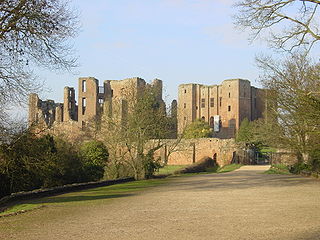
The Dictum of Kenilworth, issued on 31 October 1266, was a pronouncement designed to reconcile the rebels of the Second Barons' War with the royal government of England. After the baronial victory at the Battle of Lewes in 1264, Simon de Montfort took control of royal government, but at the Battle of Evesham the next year Montfort was killed, and King Henry III restored to power. A group of rebels held out in the stronghold of Kenilworth Castle, however, and their resistance proved difficult to crush.

Edward I, also known as Edward Longshanks and the Hammer of the Scots, was King of England from 1272 to 1307. Concurrently, he was Lord of Ireland, and from 1254 to 1306 he ruled Gascony as Duke of Aquitaine in his capacity as a vassal of the French king. Before his accession to the throne, he was commonly referred to as the Lord Edward. The eldest son of Henry III, Edward was involved from an early age in the political intrigues of his father's reign. In 1259, he briefly sided with a baronial reform movement, supporting the Provisions of Oxford. After reconciliation with his father, he remained loyal throughout the subsequent armed conflict, known as the Second Barons' War. After the Battle of Lewes, Edward was held hostage by the rebellious barons, but escaped after a few months and defeated the baronial leader Simon de Montfort at the Battle of Evesham in 1265. Within two years, the rebellion was extinguished and, with England pacified, Edward left to join the Ninth Crusade to the Holy Land in 1270. He was on his way home in 1272 when he was informed of his father's death. Making a slow return, he reached England in 1274 and was crowned at Westminster Abbey.

Edward III, also known as Edward of Windsor before his accession, was King of England from January 1327 until his death in 1377. He is noted for his military success and for restoring royal authority after the disastrous and unorthodox reign of his father, Edward II. Edward III transformed the Kingdom of England into one of the most formidable military powers in Europe. His fifty-year reign was one of the longest in English history, and saw vital developments in legislation and government, in particular the evolution of the English Parliament, as well as the ravages of the Black Death. He outlived his eldest son, Edward the Black Prince, and was succeeded by his grandson Richard II.
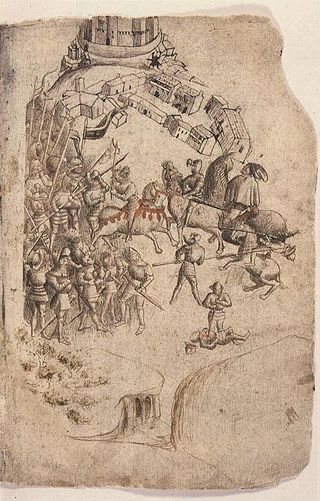
The Battle of Bannockburn was fought on 23–24 June 1314, between the army of Robert the Bruce, King of Scots, and the army of King Edward II of England, during the First War of Scottish Independence. It was a decisive victory for Robert Bruce and formed a major turning point in the war, which ended 14 years later with the restoration of Scottish independence under the Treaty of Edinburgh–Northampton. For this reason, the Battle of Bannockburn is widely considered a landmark moment in Scottish history.
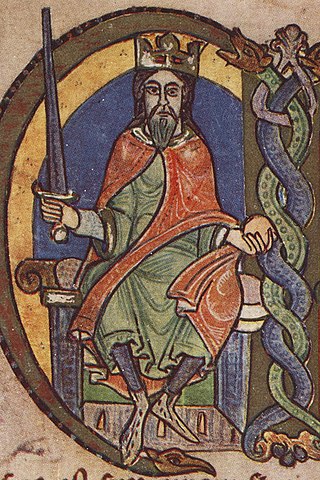
David I or Dauíd mac Maíl Choluim was a 12th-century ruler and saint who was Prince of the Cumbrians from 1113 to 1124 and later King of Scotland from 1124 to 1153. The youngest son of Malcolm III and Margaret of Wessex, David spent most of his childhood in Scotland, but was exiled to England temporarily in 1093. Perhaps after 1100, he became a dependent at the court of King Henry I of England, by whom he was influenced.
Robert Burnell was an English bishop who served as Lord Chancellor of England from 1274 to 1292. A native of Shropshire, he served as a minor royal official before entering into the service of Prince Edward, the future King Edward I of England. When Edward went on the Eighth Crusade in 1270, Burnell stayed in England to secure the prince's interests. He served as regent after the death of King Henry III of England while Edward was still on crusade. He was twice elected Archbishop of Canterbury, but his personal life—which included a long-term mistress who was rumoured to have borne him four sons—prevented his confirmation by the papacy. In 1275 Burnell was elected Bishop of Bath and Wells, after Edward had appointed him Lord Chancellor in 1274.
Robert Winchelsey was an English Catholic theologian and Archbishop of Canterbury. He studied at the universities of Paris and Oxford, and later taught at both. Influenced by Thomas Aquinas, he was a scholastic theologian.
The Battle of Halidon Hill took place on 19 July 1333 when a Scottish army under Sir Archibald Douglas attacked an English army commanded by King Edward III of England and was heavily defeated. The year before, Edward Balliol had seized the Scottish Crown from five-year-old David II, surreptitiously supported by Edward III. This marked the start of the Second War of Scottish Independence. Balliol was shortly expelled from Scotland by a popular uprising, which Edward III used as a casus belli, invading Scotland in 1333. The immediate target was the strategically-important border town of Berwick-upon-Tweed, which the English besieged in March.

Edmund of Woodstock, 1st Earl of Kent, whose seat was Arundel Castle in Sussex, was the sixth son of King Edward I of England, and the second by his second wife Margaret of France, and was a younger half-brother of King Edward II. Edward I had intended to make substantial grants of land to Edmund, but when the king died in 1307, Edward II refused to respect his father's intentions, mainly due to his favouritism towards Piers Gaveston. Edmund remained loyal to his brother, and in 1321 he was created Earl of Kent. He played an important part in Edward's administration as diplomat and military commander and in 1321–22 helped suppress a rebellion.

Antony Bek was a bishop of Durham and the Patriarch of Jerusalem.

The destrier is the best-known war horse of the Middle Ages. It carried knights in battles, tournaments, and jousts. It was described by contemporary sources as the Great Horse, due to its significance.

John of Brittany, 4th Earl of Richmond, was an English nobleman and a member of the Ducal house of Brittany, the House of Dreux. He entered royal service in England under his uncle Edward I, and also served Edward II. On 15 October 1306 he received his father's title of Earl of Richmond. He was named Guardian of Scotland in the midst of England's conflicts with Scotland and in 1311 Lord Ordainer during the baronial rebellion against Edward II.

In the Middle Ages, boats were used to transport horses over long distances, both for war and for trade. They can be found from the Early Middle Ages, in Celtic, Germanic and Mediterranean traditions.
The Ordinances of 1311 were a series of regulations imposed upon King Edward II by the peerage and clergy of the Kingdom of England to restrict the power of the English monarch. The twenty-one signatories of the Ordinances are referred to as the Lords Ordainers, or simply the Ordainers. English setbacks in the Scottish war, combined with perceived extortionate royal fiscal policies, set the background for the writing of the Ordinances in which the administrative prerogatives of the king were largely appropriated by a baronial council. The Ordinances reflect the Provisions of Oxford and the Provisions of Westminster from the late 1250s, but unlike the Provisions, the Ordinances featured a new concern with fiscal reform, specifically redirecting revenues from the king's household to the exchequer.
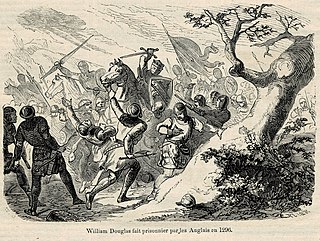
The sack of Berwick was the first significant battle of the First War of Scottish Independence in 1296.
The Remonstrances of 1297 were a set of complaints presented by a group of nobles in 1297, against the government of King Edward I of England. Foremost among the nobles were Roger Bigod, Earl of Norfolk, Marshal of England, and Humphrey de Bohun, Earl of Hereford, Constable of England.

The Boulogne agreement was a document signed by a group of English magnates in 1308, concerning the government of Edward II. After the death of Edward I in 1307, discontent soon developed against the new king. This was partly due to lingering problems from the previous reign, but also related to issues with Edward II himself. Particularly his abandonment of the Scottish Wars and his patronage of the unpopular Piers Gaveston caused discontent. Drawn up in Boulogne-sur-Mer during the king's nuptials, the document vaguely asserted the signatories' duty to guard the rights of the Crown. Three months later, the agreement was the basis for another document, justifying opposition to the king. This latter document, the so-called Declaration of 1308, is notable for its use of the "doctrine of capacities": the distinction between the person of the King and the institution of the Crown.

The conquest of Wales by Edward I took place between 1277 and 1283. It is sometimes referred to as the Edwardian conquest of Wales, to distinguish it from the earlier Norman conquest of Wales. In two campaigns, in 1277 and 1282–83, respectively, Edward I of England first greatly reduced the territory of Llywelyn ap Gruffudd, and then completely overran it, as well as the other remaining Welsh principalities.
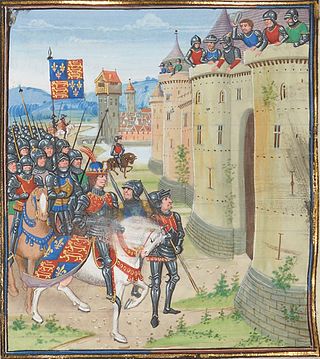
The siege of Berwick lasted four months in 1333 and resulted in the Scottish-held town of Berwick-upon-Tweed being captured by an English army commanded by King Edward III. The year before, Edward Balliol had seized the Scottish Crown, surreptitiously supported by Edward III. He was shortly thereafter expelled from the kingdom by a popular uprising. Edward III used this as a casus belli and invaded Scotland. The immediate target was the strategically important border town of Berwick.
The English invasion of Scotland of 1296 was a military campaign undertaken by Edward I of England in retaliation to the Scottish treaty with France and the renouncing of fealty of John, King of Scotland and Scottish raids into Northern England.